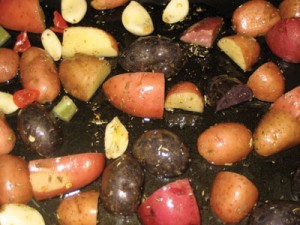Managing Blood Sugar
Every 20 seconds, someone in the U.S. is diagnosed with diabetes. Managing your total amount of carbohydrate intake in a meal is essential to controlling blood sugar, and knowing how fast a carbohydrate enters the bloodstream can help.
The speed at which carbs enter the blood is measured by the glycemic index. The higher a food’s glycemic index, the faster it increases blood sugar levels and insulin secretion. When insulin is elevated, fat storage is increased. But how quickly a carbohydrate is transformed into glucose entering the blood may be altered.
A food’s preparation affects its glycemic index. The more a food is processed, the more it’s refined, causing a breakdown in cell walls and permitting the carbohydrates to travel and be absorbed faster
as simple sugars. Example: Instant rice has a higher glycemic index than brown rice because of processing. The good news is that fat decreases a given carbohydrate’s absorption into the blood. Example: High-fat ice cream has a lower glycemic index than low fat ice cream—surprised?
Here’s how some foods rank on the glycemic index:
Low (glycemic index less than 40): barley, red lentils, soybeans, peaches, plums, fructose, peanuts, artichokes, asparagus, broccoli, cucumber, eggplant, green beans, peppers, snow peas, tomatoes, summer squash, cherries, lettuce, mushrooms, onions, walnuts, cashews.
Moderate (glycemic index of 40–60): haricot (white) beans, tomato soup, brown beans, lima beans, dried green peas, chickpeas, butter beans, black-eyed peas, kidney beans, black beans, oranges, apples, apple juice, pears, yogurt, high-fat ice cream, whole milk, 2% milk and skim milk.
Moderately high (glycemic index of 60–80): buckwheat, bran, rye bread, pumpernickel, bulgur, white pastas (e.g., macaroni, spaghetti), yams, sweet potato, marrowfat peas, frozen peas, canned baked beans, canned kidney beans, fruit cocktail, grapefruit juice, orange juice, pineapple juice, canned pears, grapes, oatmeal cookies, potato chips, sponge cake.
High (glycemic index of 80–100): wheat bread, whole meal, corn tortillas, shredded wheat, muesli, crisp rye bread, whole meal rye bread, brown and white rice, oats, fresh corn, fresh potato, apricots, raisins, bananas, papaya, mango, sucrose, corn chips, crackers, cookies, pastry, low-fat ice cream.
Extremely high (glycemic index greater than 100): puffed rice, bagels, donuts, cornflakes, instant rice, instant potatoes, cooked parsnips, baked potato, cooked carrots, fava beans and simple sugars (e.g., maltose, glucose, honey).
The glycemic index is a tool to determine which carbohydrates will help you manage your blood sugar. Choosing foods that are ranked lower on the glycemic index will help increase the healthiness of your meals.
About the Author
Jim Sayih, MS, CSCS, is CEO of 9-1-1 Fitness Inc. Contact him via e-mail at jim@911fitness.com, or visit www.911fitness.com.
Originally published in Public Safety Communications magazine, Vol. 76(11):18, November 2010.
Related Link
- “Tips to 6-Pack Abs,” by Jim Sayith. Public Safety Communications. December 2010.


